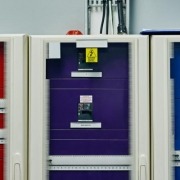As Data Centers Focus on Density, GaN Looks Increasingly Attractive
This article by GaN Systems VP of Strategic Marketing Paul Wiener was published in full 3/31/21 on Data Center Knowledge. Read the full, unabridged article here.
Conversations about GaN power semiconductors in the data center are changing.
Widespread adoption in the data center industry seems inevitable, given its many advantages over legacy silicon MOSFET solutions, but it’s being impeded by the method upon which GaN value is assessed in data center applications.
The dialogue between today’s global data center leaders and power supply and server vendors has been ongoing for some time, and it’s starting to show encouraging signs, with both internal and external forces helping to drive the conversation forward. Let’s take a deeper look at those forces and how they are leading to changes in the data center.
Let’s start with two market dynamics: data center growth and the environment. With 44 zettabytes of data residing in our data centers coming from 8 to 30 billion connected devices all over the world and about a 10 percent increase in data center growth expected in the next year, the need to change data center economics through power supply design has never been more apparent.
The perfect storm of increased infrastructure spending, new regulatory policies requiring higher power supply efficiency, and demands for increased power density inside the data center has brought the industry to an inflection point at a time when data centers account for 1 percent of the world’s energy use – a portion that’s projected to grow.
Data center leaders have addressed their industry’s unprecedented growth by leaning on new and improved corporate sustainability practices focused on renewable energy and water recycling. Some have deployed data centers in Nordic regions, for example, where both air temperature and the incoming water are cold, to avoid having to push chillers so hard. Some have invested in AI to optimize data center cooling . While these are all positive steps with favorable results, one of the root sources of heat and power consumption also requires change and improvement.
By replacing legacy power supplies based on silicon MOSFETs with GaN transistor-based designs data centers power supplies can more easily achieve higher operating efficiency. In addition to saving energy costs, this benefit correlates with today’s culture of energy responsibility and C-Suite prioritization of sustainability. Incrementally, GaN-based power supplies can deliver 2X the power in the same size, or the same power in 1/2 the size.
But, as mentioned, there are also external forces at work adding to the pressure. For example, the European Union’s “Lot 9” 2023 regulatory policies focusing on data center infrastructure as related to power supply and energy efficiency requirements will have a significant impact on the future of data center power supply design. Over the next year, GaN‘s major impact will be centered on enabling new levels of combined efficiency and power density.
Changing Metrics
This brings us to system cost and making the case for GaN from an economic standpoint. While this conversation is still ongoing, all corners of the data center ecosystem are starting to look at costs differently. Specifically, we’re seeing the key power supply metric in the industry shifting from dollars-per-watt to dollars-per-density, a metric where density is a measure of size and power of the power supply.
This metric is critical to the overall server design, whereby a half-sized power supply opens up the server for more DIMM storage, where demand is forecasted to skyrocket. Hence, dollars-per-density will ultimately influence server design and strategic data center decisions to become a dominant figure of merit.
How else is GaN impacting the data center? Read the full, unabridged article here.


